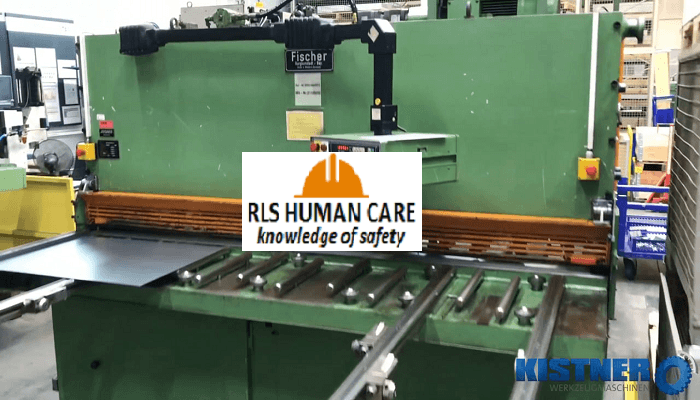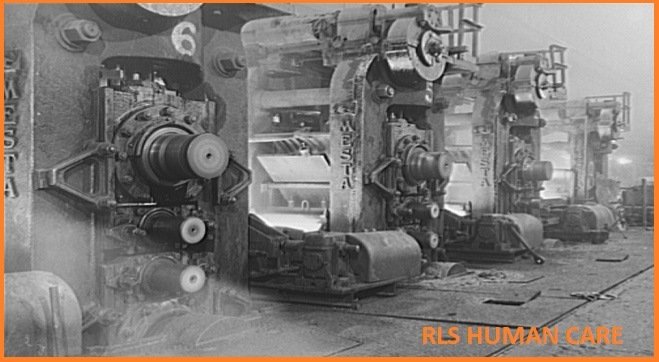For Shears, Slitters and Guillotine Machines under Schedule 6
Squaring shears should have fixed barrier guard placed at least 12 mm away front the shear (knife) and not more than 10 mm above the table or it may be a self-adjusting barrier which will automatically adjust itself to the thickness to be cut with a limit of 8 mm above the table.
The guard should extend across the full width of the table and it may be stotted, perforated or set at an angle to permit good visibility of the cutting line. The hold-down can be guarded separately or as a part of the knife guard.
The back of the knife should also be guarded and chutes or slides should be attached to catch the work without reaching close to the knife. The entire length of the treadles should be provided with fixed guarded allowing only a gap for the operator’s foot. To avoid the accidental tripping of the shear, an extra foot latch may be attached to the treadle.

Metal Shears
Alligator shears are used in forging operations. For cutting rods and bar stock to length, the alligator shear operates continuously and the operator must be trained to time his movement with the opening and closing of the cutter. An adjustable guard should be set close to prevent the fingers from entering the danger zone.
Contents
Forming Rolls:
The nip point (full length) between the rolls should be guarded utilizing a feed table. A special-purpose feeding device (channel type) can be easily installed to feed short pieces. Reverse electric switches or emergency tripping bars are also useful. Brakes are necessary if the rolls continue to revolve after power has been cut off.
Bending and Forming Machine:
This power-driven machine is used to band performed stock (ie. plate, bar, tube, pipe etc.) into desired shapes. Forming and banding are performed by dies, banding punches or other tools.
Hazards are – Trapping in dies or in-running nips of rollers, sharp corners of materials, slipping due to lubricants and heating due to the friction of motion etc. Point of operation should be guarded. Power transmission parts should be enclosed. The safety stop switch is necessary and accidental restarting should be prevented.
Metal Cutting Machine:

Metal Cutting Machine:
The metal cutting machine has a blade (hacksaw) which works horizontally and cut the stock (bar, rod, plate, pipe, tube, etc.) Coolant or lubricant is necessary. Hazards and control are similar to the wood cutting machine. Guard is required to protect the moving blade and transmission machinery.
Cold Rolling Mills:
In cold Rolling nip guards on rolls are necessary to avoid trapping. Dangerous parts of shearing, cropping, trimming and guillotine machines should be securely guarded. Oil spillage on floors should be cleaned. Gratings, absorbent materials, and non-slip boots are necessary. Fire protection in plants containing hydraulic equipment is necessary. Accidents due to material handling should be avoided by methods stated. Good housekeeping and good illumination are also essential. PPE like Hard hats, safety shoes, gaiters, gloves, goggles etc. should be worn.
Noise is at many places such as gearbox of rolls and straightening machines, pressure water pumps, shears and saws, throwing of metal products. Planning at the design stage to segregate such noise zone is essential. Soundproof and heat radiation-proof cabins for operators and crane drivers increase safety as well as efficiency. If technical control of noise is impossible or insufficient, ear protectors should be given to workers.
Vibration due to percussion tools and recoiling and rebounding effect of the material introduced into the gap between the rolls may cause health hazards for which engineering control is the only best remedy. Other measures are less effective.









